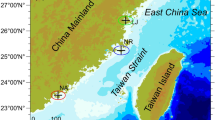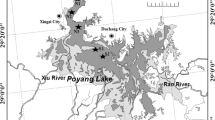Abstract
Brown tides caused by the excessive growth of the pelagophyte Aureococcus anophagefferens have occurred frequently in Qinhuangdao, China, since 2009. In this study, the temporal and spatial variations of A. anophagefferens and Minutocellus polymorphus were analyzed using real-time fluorescent quantitative PCR. The relationship between nutrient contents and brown tide events as well as the impacts of the brown tides on the composition of phytoplankton is discussed. The results showed that A. anophagefferens reached peak densities in July. Brown tides occurred in the coastal waters of Funing and Changli, and the main affected areas shifted from south to north throughout the experiment. The A. anophagefferens brown tide event was not monospecific, as M. polymorphus and Prorocentrum minimum were also observed. A redundancy analysis (RDA) indicated that decreasing concentrations of dissolved inorganic nitrogen (DIN) and increasing concentrations of the available organic nitrogen compounds (urea, dissolved free amino acids (DFAA), and dissolved combined amino acids (DCAA)) from March to June may have resulted in the outbreak of the brown bloom of A. anophagefferens, coinciding with a reduction in the community diversity of phytoplankton in the coastal waters of Qinhuangdao.






Similar content being viewed by others
References
Anderson DM, Burkholder JM, Cochlan WP, Glibert PM, Gobler CJ, Heil CA, Kudela RM, Parsons ML, Jack Rensel JE, Townsend DW, Trainer VL, Vargo GA (2008) Harmful algal blooms and eutrophication: examining linkages from selected coastal regions of the United States. Harmful Algae 8:39–53
Berg GM, Repeta DJ, LaRoche J (2002) Dissolved organic nitrogen hydrolysis rates in axenic cultures of Aureococcus anophagefferens (Pelagophyceae): comparison with heterotrophic bacteria. Appl Environ Microbiol 68:401–404
Berg GM, Balode M, Purina I, Bekere S, Béchemin C, Maestrini S (2003) Plankton community composition in relation to availability and uptake of oxidized and reduced nitrogen. Aquat Microb Ecol 30:263–274
Bricelj V, MacQuarrie S, Schaffner R (2001) Differential effects of Aureococcus anophagefferens isolates (“brown tide”) in unialgal and mixed suspensions on bivalve feeding. Mar Biol 139:605–616
Bulletin of Marine Disaster of China, (2013) http://www.coi.gov.cn/gongbao/nrzaihai/nr2013/201403/t20140324_30685.html (in Chinese)
Buschmann AH, López DA, Medina A (1996) A review of the environmental effects and alternative production strategies of marine aquaculture in Chile. Aquac Eng 15:397–421
Cao X, Xia X, He J (2010) Present situation and scientific development suggestions on scallop aquaculture in Qinhuangdao. Hebei Fishery 45–47 (in Chinese)
Cosper EM, Dennison WC, Carpenter EJ, Bricelj VM, Mitchell JG, Kuenstner SH, Colflesh D, Dewey M (1987) Recurrent and persistent brown tide blooms perturb coastal marine ecosystem. Estuaries 10:284–290
Cosper EM, Dennison W, Milligan A (1989) An examination of environmental factors important to initiating and sustaining brown tide blooms. In: Cosper EM, Bricelj VM, Carpenter EJ (eds) Novel phytoplankton blooms: causes and impacts of recurrent brown tides and other unusual blooms. Springer, Berlin, pp. 317–340
DeYoe HR, Stockwell DA, Biolagare RR, Latasa M, Johnson PW, Hargraves PE, Suttle CA (1997) Description and characterization of Aureoumbra lagunensis and referral of Aureoumbra and Aureococcus to the Pelagophyceae. J Phycol 33:1042–1048
Dong HP, Huang KX, Wang HL, SH L, Cen JY, Dong YL (2014) Understanding strategy of nitrate and urea assimilation in a Chinese strain of Aureococcus anophagefferens through RNA-seq analysis. PLoS One 9:e111069
Dzurica S, Lee C, Cosper EM, Carpenter EJ (1989) Role of environmental variables, specifically organic compounds and micronutrients, in the growth of the chrysophyte Aureococcus anophagefferens. In: Cosper EM, Carpenter EJ, Bricelj VM (eds) Novel phytoplankton bloom: causes and impacts of recurrent brown tides and other unusual blooms. Springer, Berlin, pp. 229–252
Gobler CJ, Sunda WG (2012) Ecosystem disruptive algal blooms of the brown tide species, Aureococcus anophagefferens and Aureoumbra lagunensis. Harmful Algae 14:36–45
Gobler CJ, Renaghan MJ, Buck NJ (2002) Impacts of nutrients and grazing mortality on the abundance of Aureococcus anophagefferens during a New York brown tide bloom. Limnol Oceanogr 47:129–141
Gobler CJ, Boneillo GE, Debenham CJ, Caron DA (2004) Nutrient limitation, organic matter cycling, and plankton dynamics during an Aureococcus anophagefferens bloom. Aquat Microb Ecol 35:31–43
Gobler CJ, Lonsdale DJ, Boyer GL (2005) A review of the causes, effects, and potential management of harmful brown tide blooms caused by Aureococcus anophagefferens (Hargraves et Sieburth). Estuaries 28:726–749
Gong H, Kong F, Wang Y, Yan T, Zhou M (2015) Effect of “Brown Tide” on survival and ingestion of Artemia Salina and Brachionus plicatilis in Qinhuangdao. Marine Sciences 39:30–36 in Chinese
Grasshoff K, Ehrhardt M, Kremling K (1983) Methods of seawater analysis, 2nd ed. Verlag Chemie, Weinheim, Germany
Guillard RRL, Ryther JH (1962) Studies on marine planktonic diatoms: I. Cyclotella nana Hustedt and Detonula confervacea (Cleve). Can J Microbiol 8:229–239
Guo H, Liu Y, Zhang Q, Yuan X, Zhang W, Zhang Z (2015) A quantitative polymerase chain reaction assay for the enumeration of brown tide algae Aureococcus anophagefferens in coastal waters of Qinhuangdao. Acta Oceanol Sin 34:132–136
Kaiser K, Benner R (2005) Hydrolysis-induced racemization of amino acids. Limnol Oceanogr Meth 3:318–325
Kaspar HF, Gillespie PA, Boyer IC, MacKenzie AL (1985) Effects of mussel aquaculture on the nitrogen cycle and benthic communities in Kenepuru Sound, Marlborough Sounds, New Zealand. Mar Biol 85:127–136
Keller AA, Rice RL (1989) Effects of nutrient enrichment on natural populations of the brown tide phytoplankton Aureococcus anophagefferens (Chrysophyceae). J Phycol 25:636–646
Kokkinakis SA, Wheeler PA (1987) Nitrogen uptake and phytoplankton growth in coastal upwelling regions. Limnol Oceanogr 32:1112–1123
Kong F, Yu R, Zhang Q, Yan T, Zhou M (2012a) Pigment characterization for the 2011 bloom in Qinhuangdao implicated “brown tide” events in China. Chin J Oceanol Limnol 30:361–370
Kong FZ, RC Y, Zhang QC, Wang YF, Yan T, Zhou MJ (2012b) Primary analyses on the causative species of a bloom in the Sanggou Bay. Mar Environ Sci 31:824–829 (in Chinese, with English abstract)
LaRoche J, Nuzzi R, Waters R, Wyman K, Falkowski P, Wallace D (1997) Brown tide blooms in Long Island’s coastal waters linked to interannual variability in groundwater flow. Glob Chang Biol 3:397–410
Liu AY, Song XK, Qin HW, Liu LJ, Liu XJ, Ren LH, Bai YY, Jin Y (2013) Analysis on brown tide of Aureococcus anophagefferens at Yantai Sishili Bay, year 2011. Trans Oceanol Limnol 3:73–79 (in Chinese, with English abstract)
Lomas MW, Glibert PM (1999) Temperature regulation of nitrate uptake: a novel hypothesis about nitrate uptake and reduction in cool-water diatoms. Limnol Oceanogr 44:556–572
Lonsdale DJ, Cosper EM, Kim W, Doall M, Divadeenam A, Jónasdóttir SH (1996) Food web interactions in the plankton of Long Island bays, with preliminary observations on brown tide effects. Mar Ecol Prog Ser 134:247–263
Luo H, Duan X, Bao H, Jin Z, Sun F, Liu Y, Ma M, Feng Z (2015) The temporal and spatial variation and eutrophication assessment of nutrient salts in Changli Natural Preserve. Mar Environ Sci 34:540–545 (in Chinese)
Macintyre HL, Lomas MW, Cornwell J, Suggett DJ, Gobler CJ, Koch EW, Kana TM (2004) Mediation of benthic-pelagic coupling by microphytobenthos: an energy-and material-based model for initiation of blooms of Aureococcus anophagefferens. Harmful Algae 3:403–437
Mulholland MR, Gobler CJ, Lee C (2002) Peptide hydrolysis, amino acid oxidation, and nitrogen uptake in communities seasonally dominated by Aureococcus anophagefferens. Limnol Oceanogr 47:1094–1108
Nelson CL, Siddall SE (1988) Effects of an algal bloom isolate on growth and survival of bay scallop (Argopecten irradians) larvae. J Shellfish Res 7:683–694
Nuzzi R, Waters RM (1989) The spatial and temporal distribution of “brown tide” in eastern Long Island. In: Cosper EM, Bricelj VM, Carpenter EJ (eds) Novel phytoplankton blooms: causes and impacts of recurrent brown tides and other unusual blooms. Springer, Berlin, pp. 117–137
Parsons TR, Maita Y, Lalli CM (1984) A manual of chemical and biological methods for seawater analysis. Pergamon, New York, USA
Popels LC, Cary SC, Hutchins DA, Forbes R, Pustizzi F, Gobler CJ, Coyne KJ (2003) The use of quantitative polymerase chain reaction for the detection and enumeration of the harmful alga Aureococcus anophagefferens in environmental samples along the United States East Coast. Limnol Oceanogr: Meth 1:92–102
Sigaud TCS, Aidar E (1993) Salinity and temperature effects on the growth and chlorophyll-a content of some planktonic algae. Bolm Inst Oceanogr 41:95–103
Smayda TJ, Villareal TA (1989) The 1985 ‘brown-tide’ and the open phytoplankton niche in Narragansett Bay during summer. In: Cosper EM, Carpenter EJ, Bricelj VM (eds) Novel phytoplankton blooms: causes and impacts of recurrent brown tides and other unusual blooms. Springer, Berlin, pp. 159–187
Smith JK, Lonsdale DJ, Gobler CJ, Caron DA (2008) Feeding behavior and development of Acartia tonsa nauplii on the brown tide alga Aureococcus anophagefferens. J Plankton Res 30:937–950
Talmage SC, Gobler CJ (2012) Effects of CO2 and the harmful alga Aureococcus anophagefferens on growth and survival of oyster and scallop larvae. Mar Ecol Prog Ser 464:121–134
Tracey GA, Steele RL, Gatzke J, Phelps DK, Nuzzi R, Waters M, Anderson DM (1989) Testing and application of biomonitoring methods for assessing environmental effects of noxious algal blooms. Springer, Berlin
Wazniak CE, Glibert PM (2004) Potential impacts of brown tide, Aureococcus anophagefferens, on juvenile hard clams, Mercenaria mercenaria, in the coastal bays of Maryland, USA. Harmful Algae 3:321–329
Wei L, Wang B, Kang R, Huo R, Randhawa V (2013) Aureococcus anophagefferens growth potential affected by coastal water toxicants. J Appl Phycol 25:145–152
Yu J, Zhang LL, Sun Y, Zhang L, Jiao WQ, Dou HQ, Guo HB, Bao ZM (2015) Diversity of nanoplankton during the brown tide in the Bohai Sea. Periodi Ocean Univ China 45:73–78 (in Chinese, with English abstract)
Yuan J, Mi T, Zhen Y, Yu Z (2012) Development of a rapid detection and quantification method of Karenia mikimotoi by real-time quantitative PCR. Harmful Algae 17:83–91
Zhang QC, Qiu LM, RC Y, Kong FZ, Wang YF (2012) Emergence of browen tides caused by Aureococcus anophagefferens Hargraves et Sieburth in China. Harmful Algae 19:117–124
Zhang L, Li W, Fang Y (2016) Analysis on the change of Argopecten irradians culture pattern in Changli. Hebei Fishery 25-27:43 (in Chinese)
Zheng X, Zhang F, Wu X, Zhang B, Wang L (2011) Nutrients in bay scallop aquaculture areas of Changli. Hebei Fishery:35–38 (in Chinese)
Acknowledgments
We thank Mr. Guodong Chen for analyzing the concentrations of dissolved inorganic nitrogen, dissolved silicate, and dissolved inorganic phosphate. We are also grateful to the Hebei Ocean and Fisheries Science Research Institute for their assistance with the collection of samples and geochemical data during the experiment.
Author information
Authors and Affiliations
Corresponding author
Ethics declarations
Funding
This study was supported by the National Marine Public Welfare Research Project (201205031) and the National Natural Science Foundation of China (Nos. 41521064, 41375143, 61271406).
Rights and permissions
About this article
Cite this article
Qiao, L., Chen, Y., Mi, T. et al. Quantitative PCR analysis of the spatiotemporal dynamics of Aureococcus anophagefferens and Minutocellus polymorphus and the relationship between brown tides and nutrients in the coastal waters of Qinhuangdao, China. J Appl Phycol 29, 297–308 (2017). https://doi.org/10.1007/s10811-016-0959-4
Received:
Revised:
Accepted:
Published:
Issue Date:
DOI: https://doi.org/10.1007/s10811-016-0959-4




